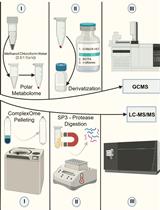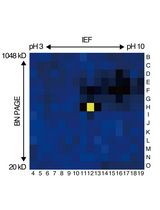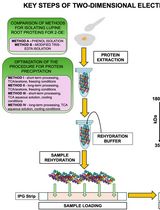- EN - English
- CN - 中文
Protein Isolation from Plasma Membrane, Digestion and Processing for Strong Cation Exchange Fractionation
用于强阳离子交换分馏的浆膜蛋白质的分离、消化和处理
发布: 2017年05月20日第7卷第10期 DOI: 10.21769/BioProtoc.2298 浏览次数: 11555
评审: Anonymous reviewer(s)

相关实验方案

利用SP3珠和稳定同位素质谱技术优化蛋白质合成速率:植物核糖体的案例研究
Dione Gentry-Torfer [...] Federico Martinez-Seidel
2024年05月05日 2835 阅读

基于活性蛋白质组学和二维聚丙烯酰胺凝胶电泳(2D-PAGE)鉴定拟南芥细胞间隙液中的靶蛋白酶
Sayaka Matsui and Yoshikatsu Matsubayashi
2025年03月05日 1938 阅读
Abstract
Plasma membrane (PM) proteins play crucial roles in diverse biological processes. But their low abundance, alkalinity and hydrophobicity make their isolation a difficult task. This protocol describes an efficient method for PM proteins isolation, digestion and fractionation so that they can be well prepared for mass spectrometry analysis.
Keywords: Plasma membrane proteins (浆膜蛋白)Background
Plasma membrane (PM) proteins participate in diverse biological processes including signal transduction, ion transport and membrane trafficking, and are the first responders in cell-environment communication. They have a complicated composition varying from species, cell types and developmental stages (Alexandersson et al., 2008). Revealing their components and the expression features comprehensively with mass spectrometry (MS) is of great importance for developmental biology. However, their hydrophobic nature and the low abundance are a big challenge for the proteomic analysis (Wu and Yates, 2003). Additives like normal surfactants, organic solvents and urea are often used to improve PM proteins’ solubility, but they will reduce the proteases’ activities and create ion suppression during MS analysis (Zhang, 2015). RapiGest SF is a novel acid-labile anionic surfactant, which is structurally and functionally similar to SDS but does not inhibit the common endopeptidases activities at low concentration (0.1% w/v). Thus RapiGest SF used in solubilizing PM proteins can not only facilitate their digestion by exposing cleavage sites but is also easily quenched by strong acid and removed through centrifugation so that the surfactant does not affect the MS identification (Yu et al., 2003). Peptides yield by the RapiGest SF-assisted digestion can directly undergo the strong cation exchange (SCX) fractionation (Yang and Wang, 2017), so that the low abundance peptides can be detected by the MS.
Materials and Reagents
- 1.5 ml tubes (Corning, Axygen®, catalog number: MCT-150-C )
- ZipTip® pipette tip (Merck Millipore, catalog number: ZTC18S096 )
- PierceTM Spin columns, screw cap (Thermo Fisher Scientific, Thermo ScientificTM, catalog number: 69705 )
- C18 (FUJIGEL HANBAI, catalog number: MB 100 - 40/75 )
- Tris (2-carboxyethyl) phosphine hydrochloride solution, 0.5 M, pH 7.0 (TCEP) (Sigma-Aldrich, catalog number: 646547 )
- Formic acid (Sigma-Aldrich, catalog number: 94318 )
- Acetonitrile (Sigma-Aldrich, catalog number: 34851 )
- RapiGest SF surfactant (WATERS, catalog number: 186001861 )
- Iodoacetamide (Sigma-Aldrich, catalog number: I1149 )
- Trypsin (Roche Diagnostics, catalog number: 11418025001 )
- Potassium phosphate dibasic trihydrate (K2HPO4·3H2O)
- Potassium phosphate monobasic (KH2PO4)
- Phosphoric acid (H3PO4)
- Ammonium chloride (Sigma-Aldrich, catalog number: A9434 )
- Hydrochloric acid (HCl)
- 0.5 M iodoacetamide stock (see Recipes)
- 0.1 μg/μl trypsin stock (see Recipes)
- 50 mM potassium phosphate buffer, pH 7.8 (see Recipes)
- 100 ml solvent A (5 mM NH4Cl, 25% [v/v] acetonitrile, pH 3.0) (see Recipes)
- 100 ml solvent B (500 mM NH4Cl, 25% [v/v] acetonitrile, pH 3.0) (see Recipes)
Equipment
- 2 μl, 10 μl, 100 μl, 1,000 μl Pipetman (Gilson, France)
- Optimal MAX-XP ultracentrifuge (Beckman Coulter, model: Optimal MAX-XP )
- AKTA purifier-10 (GE Healthcare, model: AKTApurifier 10 )
- ISS 110 SpeedVac System (Thermo Fisher Scientific, Thermo ScientificTM, model: ISS 110 )
- PolySULFOETHYL ATM columns, 2.1 x 200 mm, 5 μm particles, 300 Å poresize (PolyLC, catalog number: 202SE05 )
Software
- UNICORN 5.2 software (GE Healthcare, USA)
Procedure
文章信息
版权信息
© 2017 The Authors; exclusive licensee Bio-protocol LLC.
如何引用
Yang, N., Han, B. and Wang, T. (2017). Protein Isolation from Plasma Membrane, Digestion and Processing for Strong Cation Exchange Fractionation. Bio-protocol 7(10): e2298. DOI: 10.21769/BioProtoc.2298.
分类
植物科学 > 植物生物化学 > 蛋白质 > 分离和纯化
生物化学 > 蛋白质 > 分离和纯化
您对这篇实验方法有问题吗?
在此处发布您的问题,我们将邀请本文作者来回答。同时,我们会将您的问题发布到Bio-protocol Exchange,以便寻求社区成员的帮助。
Share
Bluesky
X
Copy link












